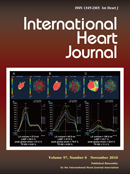57 巻, 6 号
選択された号の論文の23件中1~23を表示しています
- |<
- <
- 1
- >
- >|
Editorials
-
2016 年 57 巻 6 号 p. 659-660
発行日: 2016年
公開日: 2016/12/02
[早期公開] 公開日: 2016/11/04PDF形式でダウンロード (788K) -
2016 年 57 巻 6 号 p. 661-662
発行日: 2016年
公開日: 2016/12/02
[早期公開] 公開日: 2016/11/04PDF形式でダウンロード (457K)
Reviews
-
2016 年 57 巻 6 号 p. 663-671
発行日: 2016年
公開日: 2016/12/02
[早期公開] 公開日: 2016/11/04PDF形式でダウンロード (1944K) -
2016 年 57 巻 6 号 p. 672-675
発行日: 2016年
公開日: 2016/12/02
[早期公開] 公開日: 2016/11/04PDF形式でダウンロード (527K)
Clinical Studies
-
2016 年 57 巻 6 号 p. 676-681
発行日: 2016年
公開日: 2016/12/02
[早期公開] 公開日: 2016/11/04PDF形式でダウンロード (637K) -
2016 年 57 巻 6 号 p. 682-688
発行日: 2016年
公開日: 2016/12/02
[早期公開] 公開日: 2016/11/09PDF形式でダウンロード (575K) -
2016 年 57 巻 6 号 p. 689-696
発行日: 2016年
公開日: 2016/12/02
[早期公開] 公開日: 2016/11/04PDF形式でダウンロード (585K) -
2016 年 57 巻 6 号 p. 697-704
発行日: 2016年
公開日: 2016/12/02
[早期公開] 公開日: 2016/11/09PDF形式でダウンロード (582K) -
2016 年 57 巻 6 号 p. 705-711
発行日: 2016年
公開日: 2016/12/02
[早期公開] 公開日: 2016/11/04PDF形式でダウンロード (2201K) -
2016 年 57 巻 6 号 p. 712-716
発行日: 2016年
公開日: 2016/12/02
[早期公開] 公開日: 2016/11/04PDF形式でダウンロード (663K) -
2016 年 57 巻 6 号 p. 717-724
発行日: 2016年
公開日: 2016/12/02
[早期公開] 公開日: 2016/11/04PDF形式でダウンロード (1697K) -
2016 年 57 巻 6 号 p. 725-728
発行日: 2016年
公開日: 2016/12/02
[早期公開] 公開日: 2016/11/09PDF形式でダウンロード (482K) -
2016 年 57 巻 6 号 p. 729-735
発行日: 2016年
公開日: 2016/12/02
[早期公開] 公開日: 2016/11/09PDF形式でダウンロード (558K)
Experimental Studies
-
2016 年 57 巻 6 号 p. 736-741
発行日: 2016年
公開日: 2016/12/02
[早期公開] 公開日: 2016/11/04PDF形式でダウンロード (2896K) -
2016 年 57 巻 6 号 p. 742-746
発行日: 2016年
公開日: 2016/12/02
[早期公開] 公開日: 2016/11/04PDF形式でダウンロード (578K) -
2016 年 57 巻 6 号 p. 747-752
発行日: 2016年
公開日: 2016/12/02
[早期公開] 公開日: 2016/11/04PDF形式でダウンロード (1980K) -
2016 年 57 巻 6 号 p. 753-759
発行日: 2016年
公開日: 2016/12/02
[早期公開] 公開日: 2016/11/04PDF形式でダウンロード (3878K)
Case Reports
-
2016 年 57 巻 6 号 p. 760-762
発行日: 2016年
公開日: 2016/12/02
[早期公開] 公開日: 2016/11/09PDF形式でダウンロード (1880K) -
2016 年 57 巻 6 号 p. 763-765
発行日: 2016年
公開日: 2016/12/02
[早期公開] 公開日: 2016/11/04PDF形式でダウンロード (1374K) -
2016 年 57 巻 6 号 p. 766-768
発行日: 2016年
公開日: 2016/12/02
[早期公開] 公開日: 2016/11/09PDF形式でダウンロード (681K) -
2016 年 57 巻 6 号 p. 769-772
発行日: 2016年
公開日: 2016/12/02
[早期公開] 公開日: 2016/11/09PDF形式でダウンロード (1055K)
Errata
-
2016 年 57 巻 6 号 p. 773
発行日: 2016年
公開日: 2016/12/02
PDF形式でダウンロード (404K)
Announcement: UEDA Heart Award for 2016
-
2016 年 57 巻 6 号 p. 774
発行日: 2016年
公開日: 2016/12/02
PDF形式でダウンロード (416K)
- |<
- <
- 1
- >
- >|
